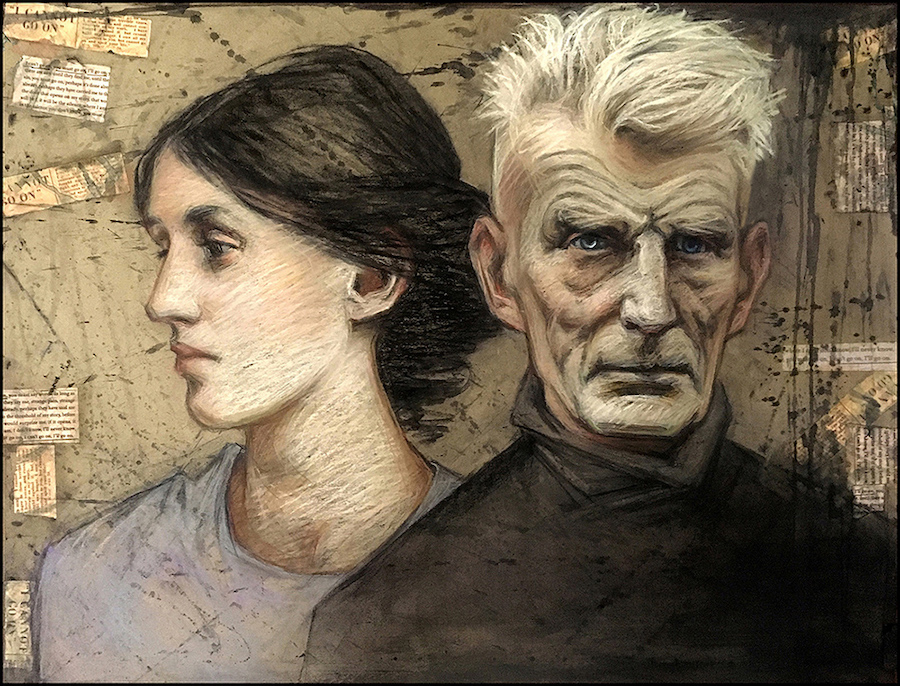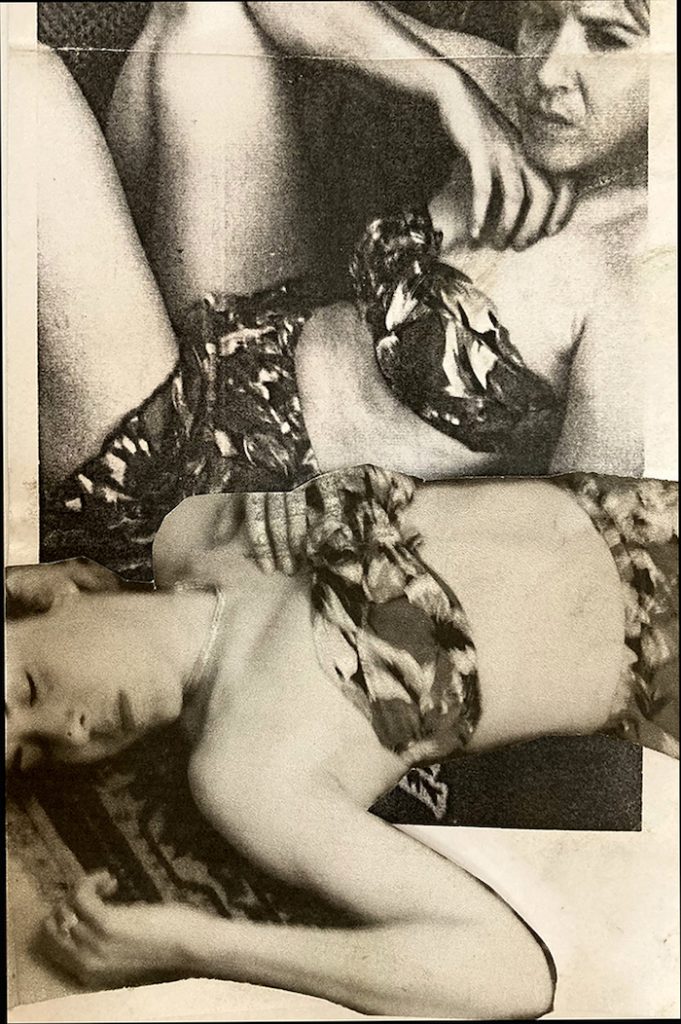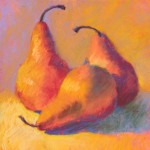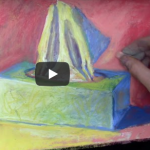I am THRILLED to introduce you to this month’s guest, Diane Rosen. I’ve been a huge fan of her work for years and so I held my breath as I reached out to invite her to guest post. She graciously accepted and I did a happy dance!
Diane’s work always has me asking questions. Her figures (generally women it seems) are so much more than traditional representations of the human body. They move towards abstraction, with focus on shape, texture, and design. They are often severely cropped and set in ambiguous contexts. With the uncertainty and tension we can feel, the paintings beg us to ask bigger questions beyond the metaphor and meaning of what’s being shown to us, questions about ourselves and our place in the world, questions about current social issues, questions about our relationship to our bodies.
I wrote about one of Diane’s paintings (you’ll see it below) in one of my monthly round-up.
Don’t know her work? Have a peek!

Before I hand you over to Diane, first a bit about her.
Diane Rosen Bio
DIANE ROSEN, a New York-based artist, studied at the Art Students League, Columbia University, and in Paris on a French Government Painting Fellowship. She exhibits widely, and her award-winning work has been featured in publications such as The Pastel Journal, American Artist, and the book, Pure Color: the Best of Pastel. She has taught studio art privately and at Parsons School of Design/The New School in New York and is the author of numerous articles on creativity and the creative process. An elected Master Pastelist of the Pastel Society of America, Diane is listed in Who’s Who of American Women and Who’s Who in American Art. You can see more of her work on her website.
Take it away Diane!
~~~~~
Thank you so much, Gail, for the opportunity to share my art with your readers! I’m honored to be your guest blogger this month.
As an art student, I never questioned that my visual language was figurative, specifically the figure: the most familiar and yet mysterious subject. To convincingly depict the embodied form and convey a sense of interior life was a thrilling goal. So I studied anatomy, drew from life till my fingers cramped, and put it all into practice while learning to paint. One day another student, a strict abstractionist, casually remarked that it was “a shame you need the crutch of figures in your work.” A crutch? To be honest, the comment triggered self-doubt and serious reflection: Is the figure really an outdated pictorial trope? Is pure abstraction the “right” path? Should I reevaluate my aesthetic priorities?

That random encounter ultimately had a very positive outcome. For one, it helped me confirm my path as a figurative artist. Figuration and abstraction are equally valid means of expression, but I knew where I felt creatively at home. More interestingly, I also realized that if you substitute the word composition for abstraction, this was already a huge part of what motivated my art, and still does: relationships of values, color, line and form, spatial organization, proportion, pattern symmetry/ asymmetry, and so on. It’s worth noting, too, that historically dominant styles inevitably shift with changes in the art market and prevailing critical taste. In a difficult moment turned serendipitous, I learned an important lesson: trust your own creative voice.

Pastels took me by surprise. Initially, I worked in oils while studying with Dan Greene at the Art Students League in New York City. Greene, a brilliant pastelist, also periodically did class demos in pastel. Watching him work with rich, pure color and bold line, I discovered that this tactile, versatile medium not only offers seemingly infinite possibilities, it perfectly suited my twin passions: drawing and painting. I was intrigued, and then hooked!
Inspiration
After art school I was fortunate to win a French Government Fellowship in Painting for my pastel work, allowing me to live and paint in Paris for a year. When not in the studio I was at the Louvre or other museums absorbing every Degas I could find. His sublime draftsmanship, unexpected use of color in flesh tones, inventive pastel techniques, and unconventional approach to composition remain an ongoing source of inspiration for me.

Like many 19th century French artists, Degas was fascinated with Japanese Ukiyo-e prints– “pictures of the floating world”– featuring scenes from everyday life. These relatively small woodblock prints included voyeuristic depictions of women bathing, combing their hair, applying makeup, and other domestic scenes. Degas transformed this style into images of women à la toilette, shopkeepers, dancers straining to hold difficult or awkward positions, idle prostitutes lounging around. Their uneasy or distracted poses have a deeply visceral effect, imbuing even ordinary subjects with an underlying psychological tension.

Ukiyo-e most likely also influenced Degas’ frequent use of decentralized composition, extreme perspective, and radical cropping that enhance an edgy pictorial energy and the feeling of implied movement. This dynamic aspect of his work has had a strong impact on how I approach composition.
Composition
I rarely do separate preliminarily drawings for specific paintings, but there’s definitely a preparatory phase! Over the years I’ve taken hundreds of photos of models (with their permission, of course!) and now have a huge archive of 4×6 inch images. When starting a new piece I’ll have a sense of the type of pose I want– open or closed, active or relaxed, standing or reclining etc. Also, I might search for images that convey a particular thought or emotion I’m preoccupied with at the time.

Sifting through many photos, a few will resonate with my general idea. I photocopy these, cut the figures out, then arrange and rearrange them without regard to actual backgrounds or spatial constraints. When this looks/feels right, the cutouts are taped onto a small sheet of paper, and, voilà: what I call a photo-sketch appears.
With this for reference, I use soft charcoal to draw directly onto my pastel paper, usually a 39×27 inch sheet. If the image doesn’t work at the larger scale, or just isn’t satisfying for whatever reason, I wipe off parts or all of it and start over. This happens a lot! The photo-sketch is a starting point, but many adjustments are made while drawing and re-drawing on the actual painting surface.

I tend to spend a long time on this part of the process, repeatedly roughing in and modifying line/form and figure/ground until relationships feel resolved. Similar to basic formalist techniques, it’s an approach that in my opinion applies to all good composition, whether abstract or figurative. This puzzle-solving aspect of composing can be frustrating, but it’s also exciting and motivating.

Whether a composition includes one figure or more, the same process applies. I love the challenge of balancing vital elements of figurative realism and essentially abstract qualities of shape, pattern, and rhythm. Linear perspective is often replaced by a free interplay of near and far, suggesting a space and place beyond logical experience. What interests me is creating environments that shift from clear to uncertain, rational to intuitive, predictable to open-ended, and situating figures within these ambiguous settings.
Mixing It Up
My preferred paper is a rough-textured, neutral pH (acid free) Murillo Fabriano 360gsm. The lightly sized surface makes it suitable for mixing dry and wet media, which I almost always do to add visual interest. In a loose, playful way, I spatter and drip acrylic paint thinned with water over the entire charcoal sketch, positive and negative areas alike. The resulting mottled patterns are random, though I may decide along the way to fling more paint at certain sections of the composition.

Any drop, drizzle or streak of paint can turn out to matter in ways I couldn’t have foreseen, so incorporating even this small element of chance evokes surprises that enrich the process for me.

A Progression
‘Anima Mundi’ is Greek for world soul, a vital force intrinsically connecting all living things on the planet. As the title of this painting, it’s meant to signify complementarity, a duality that is also a single interdependent entity. Similar to the Zen concept of yin-yang, this both-and perspective replaces traditional either-or dichotomies with other inherent, more organic kinds of equilibrium.
My photo-sketch indicated relative positioning of the two figures, but several things changed in the charcoal sketch including the amount of cropping. I’ve always enjoyed doing portraits, but when painting figure compositions I frequently crop faces extensively as I did here. This helps move the viewer’s eye through the whole composition instead of staying fixed on the strong pull that faces can exert.
Working over the entire surface I blocked in shadow-shapes first, not necessarily differentiating between figures and ground where darks were contiguous; then moving on to lights and mid-tones. At this early stage I use Nupastels because these harder sticks don’t immediately fill the paper’s tooth. From here, a variety of soft pastels — Sennelier, Rembrandt and Holbein — take center stage. As I worked on this piece, much of the prior splashing was covered by pastel, but still it helped suggest the flattened perspective and intentionally ambiguous realm inhabited by the figures.
ANIMA MUNDI is one example of the ongoing back-and-forth process that occurs in developing each of my paintings.

(This is the painting I wrote about in my Monthly roundup. You can read about here.)
Portraits
Capturing faces and hands, those revealing, ever-mobile aspects of human anatomy, has always appealed to me: how to distill unique qualities into line, form and color that convey something genuine about an individual. I’ve completed many portrait commissions and enjoyed doing that for a while. But eventually, I left it behind in favor of my “personal pantheon” series of portraits. These are imagined pairings of visionary artists and/or writers whom I greatly admire, like Virginia Woolf and Samuel Beckett or Georgia O’Keefe and Egon Schiele.


Despite their having had no connections in real life, in my mind, they are linked by intense resolve and astonishing creative power.
A Dynamic Process
I think of painting as a type of self-organizing (autopoietic) system, with order emerging from disorder through dynamics that can’t be fully understood or explained. This is absolutely not to say that paintings can’t be planned, that skills need not be honed, or that there are no guidelines to be considered! Rather, I believe that all organic change — including how paintings evolve — is fueled to some extent by processes beyond conscious awareness or control. And hooray for that!

Openness to the unexpected and a willingness to build on accidents invigorate the painting process. I’m making decisions and choices, of course, but chance factors also contribute to generating anything new.
This approach underlies my work and practice; it’s reflected in my choice of subjects, how each work is begun, and how the process unfolds. Regardless of any personal viewpoints that launch new work, each painting hopefully contains as many independent meanings as there are viewers who see it.

*****
I don’t know about you but ohhhhhh my, did I ever love reading about and seeing how Diane Rosen composes and creates her work. Her process is unusual, at least, I haven’t seen this way of putting figures together in a composition before.
One other thing I’d like to bring to your attention: many of these paintings are large!!
I hope you enjoyed Diane’s guest post as much as I did. And now it’s your turn! What’s your biggest WOW moment? I’d love to hear from you and I’m sure Diane feels the same way so if you have any thoughts, opinions, or questions, please do leave them as a comment. So look forward to hearing what you think (and feel!) about Diane’s work.
Until next time,
~ Gail
And because I can’t help myself, here’s one more image from artist Diane Rosen…

PS. Notes on the Feature Image at the start of the blog:
Diane Rosen, “Möbius Redux,” 2021, assorted soft pastels and acrylic paint on two joined sheets of Fabriano Murillo paper, 27×42 in. In mathematics the Möbius strip is an infinite loop featuring a one-sided surface without boundaries; here it symbolizes infinity and unity. Received the Blick Art Materials Award, 2021 Pastel Society Annual, National Arts Club, New York City.

































![Pastels on black aper: Gail Sibley, "Untitled [at this point], Mount Vision pastels on Sansfix pastel card, 5 1/2 x 7 3/4 in](https://www.howtopastel.com/wp-content/uploads/2016/04/IMG_9649-2-150x150.jpeg)





39 thoughts on “Diane Rosen And Her Figurative Visual Language”
Wow, what fabulous work. I so appreciate a glimpse into the background, training, and influences of an artist. And the unexpected tidbit that Degas was taken by Japanese “miniaturists”, if you will, is fascinating. I’m inspired to try some quality printmaking paper like she uses, too! Thanks Diane and thanks Gail!
Pam that’s so good to hear all your takeaways from Diane’s post! I look forward to hearing how your work goes with the printmaking paper 😁
I love Diane Rosen’s work. Her compositions are stunning and every painting is evocative and intimate. I found the discussion of the preparation of the photo sketches using cutouts from references very interesting.
I agree with you Jane about Diane’s compositions. And yes, the photo sketches process was illuminating!!
A big thank you and hurrah to Diane Rosen for an absolutely excellent essay. The image captions were especially fascinating.
Hear hear Chris!!! 🎉 I thought it was brilliant too!
Wonderful! Thanks so much for sharing.
Jessica you are so welcome!!
Thank you so much for sharing your process! Mind blown! Your work is stunning!
Yes Stacy!! Mind blown is an excellent word and state of being!!
Beautiful work. It’s so interesting to see different approaches to making art. When I see large works like this I always wonder how they are framed. Does she use glass or pexiglas?
Ohhhh Kathy, great question…which I will leave for Diane to answer. 😁
Hi Kathy. Thanks for you comment and question. Many exhibitions require works on paper to be framed using plexiglass, not glass, so the majority of my pieces are framed with plexi. Of course glass is great as well, and also offers a non-reflective option that isn’t available in plexi as far as I know.
Fascinating work, thank you so much for sharing with us! I think there is going to be a run on Fabriano Murillo paper…
Glad you enjoyed it Laura and hah hah, I think you’re right about the run on that paper….!
I did not know Diane’s work and as I scrolled down I felt my eyes widen and sparkle with delight! I admire her ability to portray the human body in such a compelling way and love the way the body becomes part of an abstract world
Hi Sal I LOVE that I’ve been able to introduce you to this fabulous artist and that you so appreciate her skill with portraying the human body. Compelling is a perfect word to use in relation to Diane’s work!!
Thanks Gail for featuring Diane’s unique and refreshing approach working with pastel and the figure. She has found away to combine realism and abstraction making a very successful body of work.
Susan, I’m delighted to feature Diane and her work and glad you’ve enjoyed her post. I do love the way she combines realism and abstraction in her figures!
Wow! Thank you so much for highlighting Diane Rosen’s work. I know that art is very subjective; I don’t have much of a relationship to abstract art in general. Occasionally, a piece will “speak” to me and I will love it but that is seldom. Therefore, I found the comment….. “One day another student, a strict abstractionist, casually remarked that it was “a shame you need the crutch of figures in your work” very amusing. I’m glad she stuck to her heart and gut feeling and wasn’t influenced by that comment. I think that figurative art is something we can all relate to. It may not look exactly as we do, but it is something inherently familiar. I went back and looked at all the pieces in this article and was really blown away by the placement of the figures, the weight of the bodies through color, light, and shadow. The marks and directions of the marks she made to create these effects. It’s given me a lot of food for thought.
Lisa thank you for your thoughts. I love that Diane’s work affected you so deeply and that you took the time to describe how they impacted you. And it made me smile to see you pick out that phrase you mentioned…it made me smile too. Different perceptions!
Thanks for introducing us to this wonderful art. As an identical twins myself, I find layers of my own connections and meaning in these pieces. Inspiring.
Ohhhh Angela, I can see how being a twin would bring a whole other layer of meaning to Diane’s pieces!!! So happy to have introduced you to her work!
Wow, talk about inspiring! Diane’s work draws you in and makes you want to explore the composition, subject and meaning behind each on which, as she said, varies from viewer to viewer. It is such a gift to be able to read about an artist’s evolution, her strength in using her own voice rather than being swayed by others, her process and compositional choices. All of these paintings are so dynamic. Thank you for inviting her as a guest, Gail, and to Diane for sharing with us her wonderfully written essay and choice of images.
And thank you Gill for sharing your own thoughts! I agree with you about the gift of another artist sharing their process and evolution and commitment as an artist – it inspires us to consider our own art practice more deeply and with resolve!
Fabulous thought-provoking work. I’m envious of an artist who finds her niche and totally leans into it. Something that eludes me. I also noticed that all of Diane’s artwork is a large format. And I see that a lot of famous successful artists do work in large formats. Should that tell me something? Anyway, loved seeing Diane’s work. Thanks again Gail!! And thanks Diane for sharing so much of your process. Really enjoyed reading about it.
Thanks Ruth!! About finding your niche…look for what you love to paint, what you can’t not paint. And don’t worry about what anyone else things. And then paint it! Perhaps Diane will share her thoughts on this.
And about painting large (and yes, much of Diane’s work is large), I think it does tell us something….about impact, about our fears of going big, about the needs of galleries, and about much more!
Hi Ruth, thanks for your kind words about my work and process. About finding a ‘niche,’ i totally agree with Gail on this. If you give yourself permission to paint what you love, to feel your way into your work by approaching it from the ‘inside out’ rather than the reverse, then in a way your niche finds you. Here’s something I recently read that seems relevant: “All you can do is keep making the work you want to see in the world.” Hope this makes sense. Cheers, and happy painting!
💓
100% Wow! Diane’s art is very magnetic and makes one seriously think! Its incredible how those “happy accidents” and unpredictable underpainting prepares her works for more spontaneous applications of pastel creating the final statement of her intention. And as she states her early layer with charcoal does not delineate between the dark shapes, as in a thumbnail preliminary study. I would guess that helps maintain the freshness of the whole piece so she can focus on her statement. Thank you for this feature artist Gail.
I really love this artist and her approach!
Oh I love a 100% wow! Brenda, thanks for picking out the aspect of accidents and unpredictability as part of Diane’s process. I’m wondering how it might affect and inspire your own work?
Yes Gail, I aim to try out some new techniques and also to return to working a bit larger which I hope to force me into loosening up. Seeking to capture a spirit or essence and step away from replicating details. My studio has a quote I copied from the wall of my local museum Fuller Craft in Brockton, “Risking and dreaming are primary acts of creativity”!
Ohhhhh yeah – LOVE that quote!!!! You go Brenda! I’ll be cheering you on in IGNITE! 😁
Amazing! I so enjoy her work. Thanks Gail for bringing Diane Rosen to us.
It is so my pleasure Gailen!!!
Yet another new artist you have introduced to me. These are stunning pictures and it is so good that Diane is happy to share her thoughts and processes with us.
Oh my gosh, I love introducing artists who are new to my readers. Yay!!! I am so glad you enjoyed Diane’s work and are appreciative of her sharing her words and process with us Aidan. Thanks!
Wow. I love love love this work.
I am heartened by her mention of an abstract artist fellow student mention being tethered to the figure. As a new artist very much in my realism phase of exploration I have had the exact same experience. I participate in a every-other-week studio group, and I am the lone realistic painter in the group, and have experience with those feelings of self-doubt because I don’t seem to have the abstraction gene. Thank you, Diane for sharing.
I also try to attend a every-other-week life drawing class where I use my pastel sticks rather than a pencil or charcoal. And now I see this wonderful way of using that opportunity to create some wonderful experimentation works of my own.
I loved looking at Diane’s website where I find her fabulous figure work as well as her far more realistic landscape work.
My spirits are absolutely lifted! Thank you, Diane for sharing your process. I was rapt – still am – and excited about trying some experimentation using my life drawings as starting points. I’m feeling the urge to clip figures from magazines and play with the placement of figures to tell my story.
Wonderful, exhilarating, I am soooo excited.
And I love love love your over-the-moon enthusiastic response Liz! Can’t wait to see your life drawing experimentations. Let’s keep on this in the IGNITE! group!